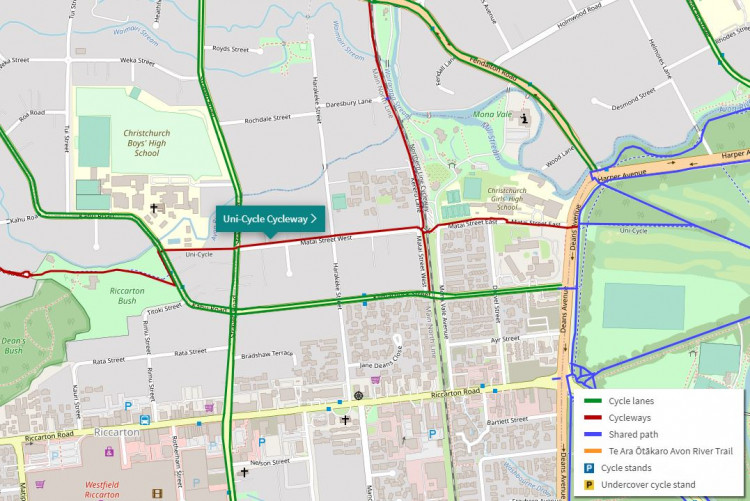Project type: Railway Level Crossing upgrade
Project elements: Shared paths, Level crossing
Project owner: Christchurch City Council with KiwiRail
Existing users of the Matai Street Level Crossing had to negotiate a tight maze arrangement as part of the safety controls over the Main North Railway Line. The crossing was already heavily utilised in morning and evening peak periods due to the location of two High Schools close by.
As two major cycle routes were proposed to use this crossing, a new solution was needed to manage the increased number of users crossing the railway at this point. The solution was to install double automated gates, something that had not been used in Christchurch before.
Project background and desired outcomes Back to top
The Uni-Cycle/Puari ki Pū-taringa-motu route provides users with a route between the central city, the University of Canterbury and the College of Education Campus. The route passes near a number of major high schools and several intermediate schools. It connects with the Northern Line/Puari ki Pū-harakeke-nui Major Cycle Route at the railway line on Matai Street, see the black circle on the map below.
The previous level crossing at the railway line on Matai Street incorporated a maze which required cyclists to dismount and walk their bicycles through the crossing as it was generally too constrained in size to cycle through, particularly with larger bikes such as cargo bikes or for people using trailers.
During the morning peak period there were large numbers of people crossing the railway line with Christchurch Boys’ High School and Girls’ High School on either side of the crossing in addition to people commuting to the city centre from the north and the west.
As the number of people walking and cycling through the crossing was due to increase with the Uni-cycle route and the Northern Line route being formalized as part of the Major Cycleway network, improvements were needed for capacity and safety. Double automated gates were the preferred choice by Christchurch City Council and KiwiRail because the number of trains that pass through this crossing are low and gates give priority to people crossing on foot and bicycle for the majority of the time when there are no trains. The gates were installed and operational in 2017. They swing shut and alarm bells ring when a train is approaching.
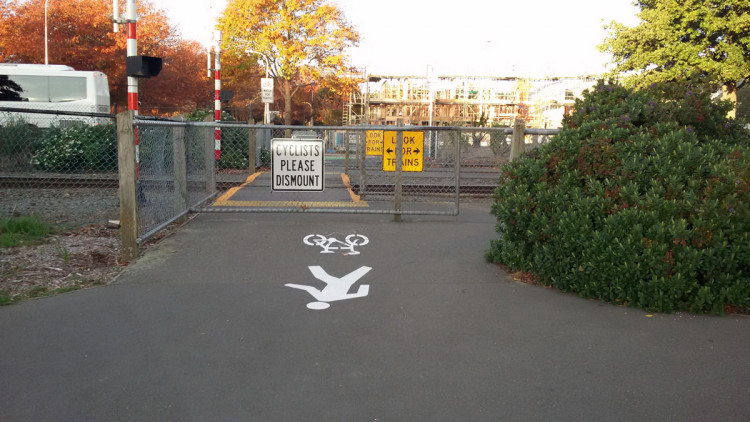
Original maze arrangement at the level crossing (photo: ViaStrada)
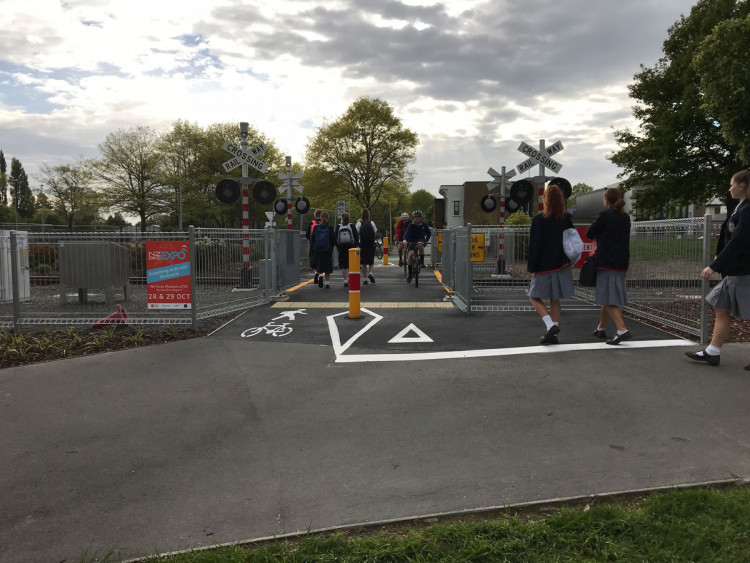
Easier for larger numbers to cross through the new crossing (photo: ViaStrada)
The upgrade of this crossing was prior to the release of the Level Crossing Safety Impact Assessment and Design Guidance for Pedestrian and Cycle Rail Crossings.
Challenges and solutionsBack to top
- How to provide a safe and accessible crossing point for large numbers of people including cyclists, pedestrians and other active users (skateboards, scooters etc) at a railway level crossing location. This was resolved by changing the maze arrangement to a direct double automated gate layout.
- How to create a layout that worked for pedestrians and cyclists when demand varied dramatically at different times of the day and the speed of the two of users differed. This was resolved by providing double gates to maximise the width of the crossing.
- How to manage the alignment of adjacent streets when there is a wide opening and concern that vehicles may choose to use the crossing when the double automated gates are open for most of the day. This was resolved by the implementation of high visibility bollards and supporting pavement markings.
- Reaching a design solution and cost share agreement with KiwiRail.
- Early and ongoing engagement with KiwiRail is recommended. Whilst the design process is generally led by KiwiRail for some elements, it should be clear who is responsible for all the different elements of design and construction.
- Sourcing concrete blocks to locate gates on held up the project due to a design change that had not been signed off by an engineer. A set of the previously designed blocks were sourced after some delay to the project.
- The design of the blocks resulted in an upstand at the gate with exposed bolts. This has created a trip hazard which could only be mitigated with yellow paint.
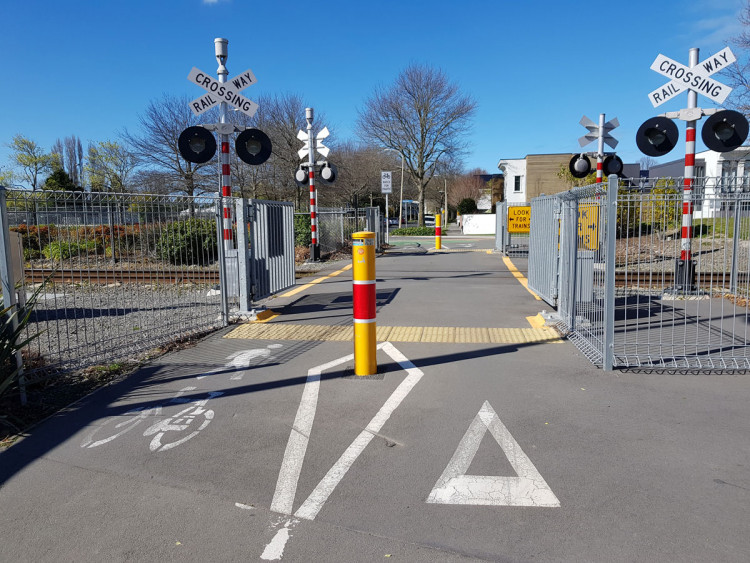
Access control devices use to prohibit vehicle movements (photo: Gemma Dioni, ViaStrada)
Successes and learningsBack to top
- The shared environment requires the user to be aware of others and with high demand at school start / end times this has been raised as a safety concern; however, no conflicts have been raised in the time that it has been operating. Extending the shared area outside of the crossing point may have improved this further.
- On the west side of the crossing there is the Northern Line Cycleway (north-south route) which crosses the Uni-cycle route (east-west) route. Visibility for people travelling west was restricted by trees and vegetation. Some vegetation was removed, and trees were cut back, however this has now created an ongoing maintenance issue and it may have been preferable to remove the trees to reduce maintenance. A give way restriction on the west bound cyclists was added to give priority to the north/south movement.
- It is important to understand the detailed design elements to ensure it works safely for users. This included:
- bolts on signage sticking out on the emergency escape gates which were snagging hazards
- the fence footings which are located in the path and could affect large numbers trying to cross in one large group (these have been highlighted with a yellow coloured surface treatment)
- the level of the gates alongside the level of the approaches allowing them to swing.
- Whilst some of these issues could be picked up through the detailed design safety audit some of these minor items were only picked up through the construction process.
- Allow time for joint responses by the path designer and KiwiRail designer during the Safety Audit process.
- Once construction started on-site KiwiRail were very reliable with their time frames and working in with Councils contractor. A good communications plan and active project management assisted with this.
- Rubber infill was not specified or deemed necessary for the area between the tracks at the time of construction and AC was used. Later KiwiRail requested that this was installed at a cost of $50,000 to Council, which was not carried out. No issues have been raised to date in terms of safety or comfort.
- The width of the crossing (approx. 3 metres wide) is determined by the width of the standard KiwiRail gates. As the major cycleway network continues to be developed and numbers further increase, there may need to be a review of the width of the crossing point to ensure it continues to operate safely and at a higher capacity in future. Particularly if there are increases in different bicycle types (tri-cycles, cargo bikes and trailers) that may require more space.
- The gates have been an improvement for the safety of all users of the crossing. Previously track marks showed that people would cut through vegetation through the unfenced section of track to cross the track if there was congestion in the maze.
- Tactile pavers were located 600mm from the gate as the gate is hazard. This is a KiwiRail requirement.
- Well designed and intuitive transitions to/from the level crossing are critical for users to be able to identify the crossing they are approaching, and to engage safely with other users when crossing the railway lines.
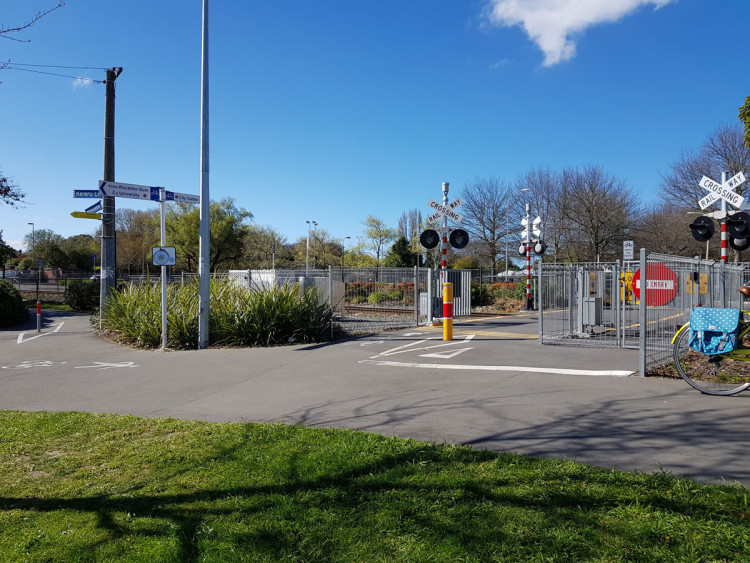
Crossroads of two major cycleways located at the level crossing (photo: Gemma Dioni, ViaStrada)
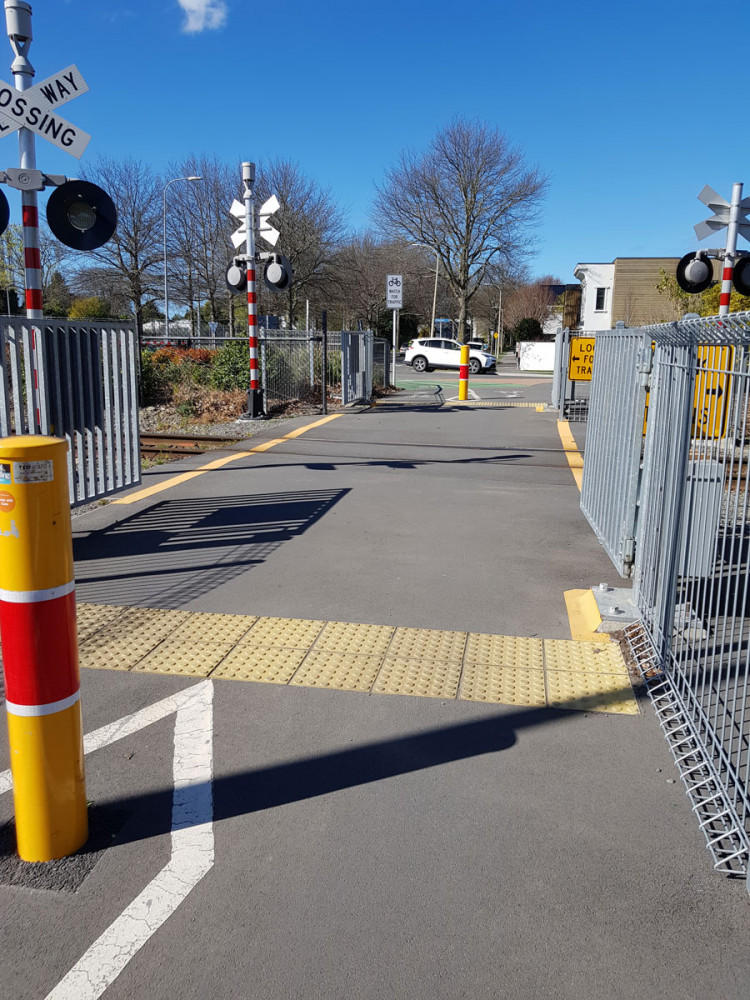
Fence and gate post foundation in the pathway (photo: Gemma Dioni, ViaStrada)
